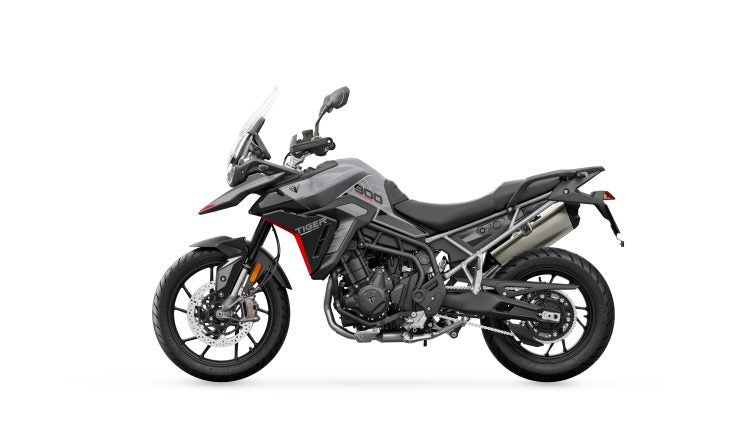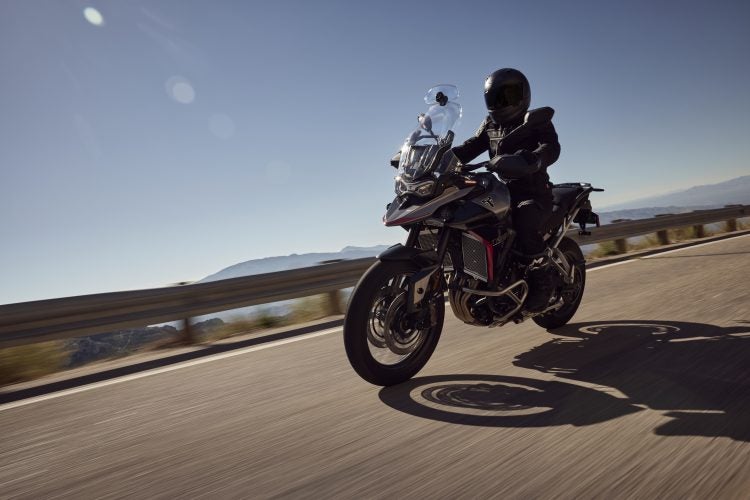What has a re-tuned three-cylinder engine, updated brakes, an overhauled chassis and a fresh new look for 2024? If your answer was the Triumph Tiger 900 series, you’d be right. For 2024, Hinckley is revising this line with three models: the Tiger 900 GT, the Tiger 900 GT Pro and the Tiger 900 Rally Pro.
Based on previous installments in the Tiger 900 series, you can probably already guess what’s coming, but here is a bike-by-bike breakdown to clarify things.

The GT is the base model. No heated seats, no spoked wheels, no quickshifter. Photo: Triumph
Tiger 900 GT
This is the base model. For 2024, it gets an overhauled engine, with more muscle. Max power is up 13 percent, to 106 hp and 66 lb-ft of torque. Triumph’s retuning job allows the engine to build that power at lower RPM than on previous models.
To get these gains, Triumph gave the bike new pistons with a higher 13.0:1 compression ratio, a new cylinder head with larger intake ports and redesigned exhaust ports, new camshafts with higher lift and new, longer intake trumpets. Of course, the liquid-cooled triple still uses the T-plane design, which offsets the firing order to give the benefits of both a twin-cylinder engine down low and a three/four-cylinder engine at higher rpm.
Along with the power boost, Triumph says the new engine sees fuel economy improve by nine percent, good for roughly 4.7L/100 km, or 50 US mpg. That works out to a theoretical range of roughly 425 km from the 5.28-gal (20L) tank, or 264 miles. Along with the improved fuel economy, Triumph also claims it scrubbed the bike’s tailpipe emissions as well, which is important in the regulatory framework of the EU.
Aside from the engine, most of the changes involve modest tweaks to the bike’s chassis and safety systems. Triumph says weight is cut a bit, but that appears to mostly be due to the new exhaust. In stock form, the bike comes with a titanium Akrapovic muffler, with carbon-fiber endcap. The header is new as well, cutting some weight. But the chassis does not appear to be changed much, and the GT gets manually-adjustable Marzocchi fork and shock that appear to be unchanged from last year’s model. Wheel travel is 7 inches up front 6.7 inches in rear. Seat height is adjustable between 32.3 and 33 in.

If you only want the GT with a couple of the updates that the Pro models come with, you can order some of those bonus bits as add-ons. But before long, you might as well have bought the Pro model instead. Those farkles add up. Photo: Triumph
Of course, the bodywork is new. Triumph did add an emergency braking warning system which activates the bike’s four-way flashers if it detects rapid deceleration. There’s a new linked braking system as well, which “applies a controlled amount of rear brake pressure automatically when the rider applies the front brake.” Triumph says this is to improve chassis stability and shorten stopping distances. This feature can be turned off, but only by deactivating the ABS system.
Speaking of which, leaning-sensitive ABS and TC systems are standard, as you’d expect, and if you go into the bike’s riding modes menu, you can tweak your ride by selecting a different mode. This is how you control the electro-interference. There are six modes (Rain, Road, Sport, Off-Road, Off-Road Pro and Rider). TC can also be switched off outside the riding modes menu; not all riding modes will be available on all machines.
Cast wheels are standard, with a 19-in front and 17-in rear. The windshield is manually adjustable using one hand. The new 7-inch TFT screen (same as on the Tiger 1200) is Bluetooth-compatible, but the Tiger series no longer has special integration with GoPro cameras as previous models had. All Tiger 900 models also have a new USB-C charger in the cockpit as well, to match the 12V charging socket and the phone storage compartment under the seat with 5V USB charger.
Wet weight is 482 lb.
The Tiger 900 GT will have an MSRP of $14,995 in the US and $16,995 in Canada.
Tiger 900 GT Pro
As you might guess, this is a higher-spec version of the GT. Same engine, same front suspension, same brakes (Brembo Stylema Monobloc calipers with radial master cylinder up front). Your difference here is mostly the options, not the important mechanical bits. The shock is the biggest exception to that rule; the GT Pro has a Marzocchi shock with remote electronic preload adjustment.

The GT Pro is optimized for street travel and comfort, with heated grips and seat, and electro-adjust shock preload. There’s also a quickshifter. Photo: Triumph
Heated seats come standard for passenger and pilot on this bike, and the pillion’s seat comes with its own controls, for max comfort. Heated grips are also standard. A TPMS readout gives you the tire pressures. And. the up/down Triumph Shift Assist quickshifter comes standard (it’s available on the standard model as an option).
Wet weight is 489 lb.
The Tiger 900 GT Pro has the same color choices as the standard GT. MSRP for 2024 is $16,895 in the US and $19,925 in Canada.
Tiger 900 Rally Pro
As the name suggests, this is the off-road friendly version of the bike, with spoked wheels that accept tubeless tires. Wheel size are a 21-in front, 18-in rear to accept a wider range of off-road tires.

The Rally Pro will get the job done off-road, with a Showa fork and shock made for the job and 21-18 wheels. Photo: Triumph
The Rally Pro also gets a Showa fork and shock with manual adjustments for preload, rebound and compression damping, with 9.5 in of travel up front and 9 in of travel in rear. Obviously, it is not made for the same sort of dune-bashing glories as some of the other more off-road oriented ADVs on the market, but it’s a boost over the GT models. Also note that this means seat height climbs to a 33.9-34.6 in range on the Rally Pro model.
While all the new Tiger 900 models come with a trick vibration-reducing handlebar mount, it’s also adapted for easier off-road ergos on the Rally Pro, moved farther back to the rider.
Wet weight is 502 lb. MSRP for this machine is $17,395 in the US, or $20,195 in Canada.
Accessories
As always, Triumph has a whole boatload of accessories for these bikes, You can order parts like bash plates, engine crash bars, windshields, luggage and lots more, paying for only the stuff you want or ordering a package to save money. Talk to your local dealer if you want a price list.







